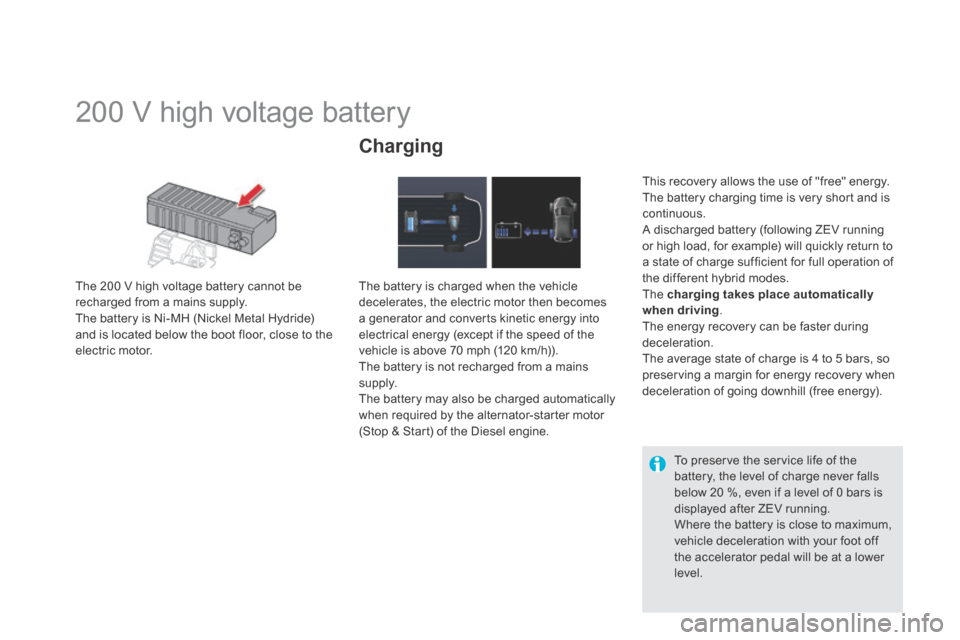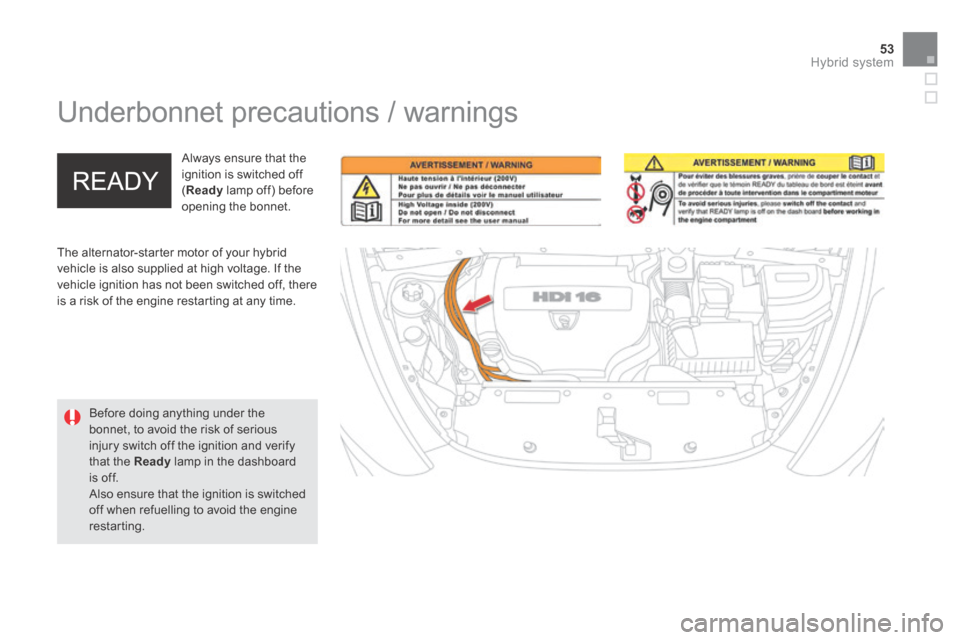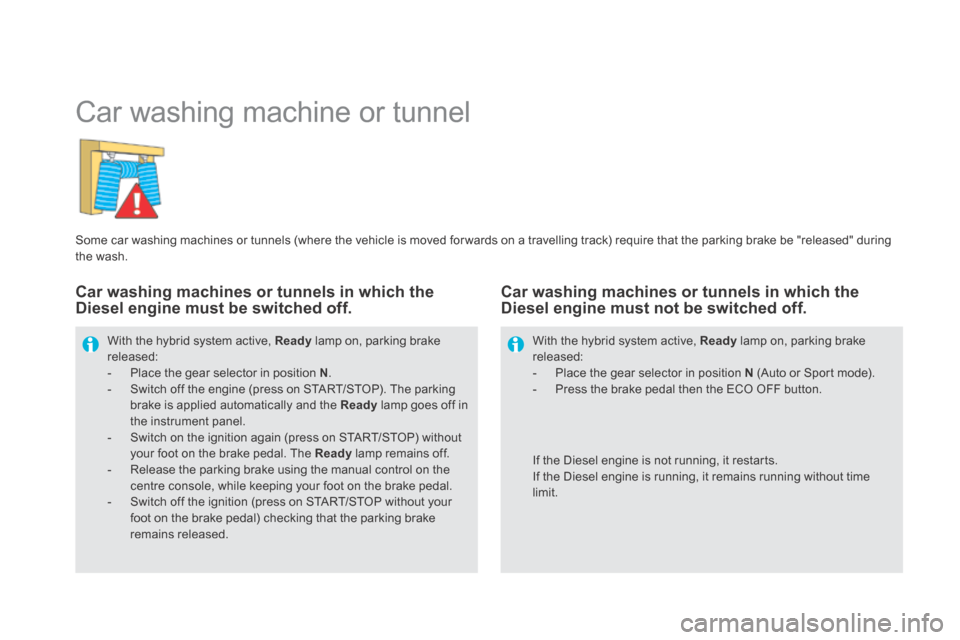Citroen DS5 HYBRID4 2014 1.G Workshop Manual
Manufacturer: CITROEN, Model Year: 2014, Model line: DS5 HYBRID4, Model: Citroen DS5 HYBRID4 2014 1.GPages: 380, PDF Size: 13.62 MB
Page 51 of 380

49Hybrid system
DS5-HYBRID_EN_CHAP00C_HYBRIDE_ED02-2013
Consumption of your hybrid in the screen
Average consumption over the last 5 minutes.
"60 % Hybrid Use" corresponds to 60 % of the cumulative running time with the addition of the hybrid system and 40 % of the time with the Diesel engine only (with no contribution from the hybrid system).
For more information on the trip computer, refer to the corresponding section.
Resetting the history
With the hybrid system active, when trip 2 displayed, press the control for 2 seconds to reset the history to zero.
Page 52 of 380

DS5-HYBRID_EN_CHAP00C_HYBRIDE_ED02-2013
200 V high voltage battery
The 200 V high voltage battery cannot be recharged from a mains supply. The battery is Ni-MH (Nickel Metal Hydride) and is located below the boot floor, close to the electric motor.
Charging
The battery is charged when the vehicle decelerates, the electric motor then becomes a generator and converts kinetic energy into electrical energy (except if the speed of the vehicle is above 70 mph (120 km/h)). The battery is not recharged from a mains supply. The battery may also be charged automatically when required by the alternator-starter motor (Stop & Start) of the Diesel engine.
This recovery allows the use of "free" energy. The battery charging time is very short and is continuous. A discharged battery (following ZEV running or high load, for example) will quickly return to a state of charge sufficient for full operation of the different hybrid modes. The charging takes place automatically when driving . The energy recovery can be faster during deceleration. The average state of charge is 4 to 5 bars, so preserving a margin for energy recovery when deceleration of going downhill (free energy).
To preserve the service life of the battery, the level of charge never falls below 20 %, even if a level of 0 bars is displayed after ZEV running. Where the battery is close to maximum, vehicle deceleration with your foot off the accelerator pedal will be at a lower level.
Page 53 of 380

51Hybrid system
DS5-HYBRID_EN_CHAP00C_HYBRIDE_ED02-2013
This system does not work continuously, but adapts the force of the fan cooling to the requirements of the battery. Its operation can be heard at the rear, even if the vehicle is stopped after a run. If the air intake is blocked, the battery may overheat, damaging the battery and causing a loss of per formance of the hybrid system.
Fan cooling of the high voltage battery
For the best use of the high voltage battery, please follow these recommendations: - do not obstruct the air intake with loose articles, otherwise, the battery may overheat, causing a loss of per formance of the hybrid system - do not spill fluids, as this may cause damage to the battery.
The high voltage battery has an air cooling system, comprising an air intake (located on the side of the left hand rear seat) and a fan (located behind the left hand boot trim panel).
Page 54 of 380

DS5-HYBRID_EN_CHAP00C_HYBRIDE_ED02-2013
The high voltage battery must not in any circumstances be charged from an external source and must only be handled by a workshop technician. There is the risk of serious burns, as well as electric arcs that could cause serious injury or even death. A used Ni-MH (Nickel Metal Hydride) type high voltage battery must be removed in an appropriate manner by a repair workshop, so that its recycling presents no risk to the environment.
High voltage
The voltage used for the operation of the electric motor is in the range 150 to 270 Volts. Be sure to take account of the warning labels fitted to the vehicle. Take great care regarding the high voltage and high temperatures of components carrying the current.
Emergency cut-off
In the event of an accident, a cut-off system blocks the high voltage current and cuts off the fuel pump; your vehicle can no longer be started.
To restart the hybrid system, contact a CITROËN dealer.
High voltage cables are routed under the vehicle (sills); take care not to damage them when the vehicle is used for off-road activity (such as covering rough ground).
Before doing any work on the vehicle, switch off the ignition ( Ready lamp off).
Battery precautions
High voltage cables
Take care to position lifting equipment ( jack, hoist, ...) at the locations provided to avoid damaging the cables.
Never touch, dismantle, remove or replace the high voltage parts, orange cables or connectors, even in the event of an accident.
Page 55 of 380

53Hybrid system
DS5-HYBRID_EN_CHAP00C_HYBRIDE_ED02-2013
Underbonnet precautions / warnings
The alternator-starter motor of your hybrid vehicle is also supplied at high voltage. If the vehicle ignition has not been switched off, there is a risk of the engine restarting at any time.
Always ensure that the ignition is switched off ( Ready lamp off) before opening the bonnet.
Before doing anything under the bonnet, to avoid the risk of serious injury switch off the ignition and verify that the Ready lamp in the dashboard is off. Also ensure that the ignition is switched off when refuelling to avoid the engine restarting.
Page 56 of 380

DS5-HYBRID_EN_CHAP00C_HYBRIDE_ED02-2013
Car washing machine or tunnel
Some car washing machines or tunnels (where the vehicle is moved for wards on a travelling track) require that the parking brake be "released" during the wash.
With the hybrid system active, Ready lamp on, parking brake released: - Place the gear selector in position N . - Switch off the engine (press on START/STOP). The parking brake is applied automatically and the Ready lamp goes off in the instrument panel. - Switch on the ignition again (press on START/STOP) without your foot on the brake pedal. The Ready lamp remains off. - Release the parking brake using the manual control on the centre console, while keeping your foot on the brake pedal. - Switch off the ignition (press on START/STOP without your foot on the brake pedal) checking that the parking brake
remains released.
If the Diesel engine is not running, it restarts. If the Diesel engine is running, it remains running without time limit.
With the hybrid system active, Ready lamp on, parking brake released: - Place the gear selector in position N (Auto or Sport mode). - Press the brake pedal then the ECO OFF button.
Car washing machines or tunnels in which the Diesel engine must be switched off. Car washing machines or tunnels in which the Diesel engine must not be switched off.
Page 57 of 380

55Hybrid system
DS5-HYBRID_EN_CHAP00C_HYBRIDE_ED02-2013
Recovery of the vehicle on a fl at-bed
Never recover the vehicle by towing it with the wheels on the ground (neither the front wheels, nor the rear wheels), as there is a risk of damage to the transmission. Before doing any work, with the ignition on, press the brake pedal and place the gear selector in position N , then switch off the hybrid system ( Ready lamp off). Always call on a professional for the recovery of your vehicle on a flat-bed lorry or trailer.
Use the towing eyes only to lash the vehicle when recovering it on a flat-bed lorry or trailer.
Page 58 of 380

DS5-HYBRID_EN_CHAP01_CONTROLE DE MARCHE_ED02-2013
Instruments and controls
Page 59 of 380

DS5-HYBRID_EN_CHAP01_CONTROLE DE MARCHE_ED02-2013
Page 60 of 380

DS5-HYBRID_EN_CHAP01_CONTROLE DE MARCHE_ED02-2013
Instrument panel
1. Energy consumption / generation indicator (available power as a percentage). For more information refer to the "Hybrid system" section. 2. Fuel gauge. 3. Engine coolant temperature gauge. 4. Speedometer (mph or km/h). 5. Cruise control or speed limiter settings.
A. Main lighting and controls dimmer. B. - Successive short presses: under-inflation detection, recall servicing information, alert log. - Long press: reset the function selected to zero (service indicator or trip recorder).
6. Gear engaged. 7. Instrument panel screen: electrical flow, trip recorder, alert messages or state of functions (e.g.: oil pressure, battery, door open, ...), trip computer, media, satellite navigation. 8. Digital speedometer (mph or km/h). 9. Ready lamp: indicates that the vehicle is ready to drive.
Dials and screens Control buttons